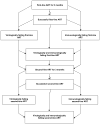Viral load monitoring of antiretroviral therapy, cohort viral load and HIV transmission in Southern Africa: a mathematical modelling analysis
- PMID: 22421243
- PMCID: PMC3750130
- DOI: 10.1097/QAD.0b013e3283536988
Viral load monitoring of antiretroviral therapy, cohort viral load and HIV transmission in Southern Africa: a mathematical modelling analysis
Abstract
Objectives: In low-income settings, treatment failure is often identified using CD4 cell count monitoring. Consequently, patients remain on a failing regimen, resulting in a higher risk of transmission. We investigated the benefit of routine viral load monitoring for reducing HIV transmission.
Design: Mathematical model.
Methods: We developed a stochastic mathematical model representing the course of individual viral load, immunological response and survival in a cohort of 1000 HIV-infected patients receiving antiretroviral therapy (ART) in southern Africa. We calculated cohort viral load (CVL; sum of individual viral loads) and used a mathematical relationship between individual viral load values and transmission probability to estimate the number of new HIV infections. Our model was parameterized with data from the International epidemiologic Databases to Evaluate AIDS Southern African collaboration. Sensitivity analyses were performed to assess the validity of the results in a universal 'test and treat' scenario, wherein patients start ART earlier after HIV infection.
Results: If CD4 cell count alone was regularly monitored, the CVL was 2.6 × 10 copies/ml and the treated patients transmitted on average 6.3 infections each year. With routine viral load monitoring, both CVL and transmissions were reduced by 31% to 1.7 × 10 copies/ml and 4.3 transmissions, respectively. The relative reduction of 31% between monitoring strategies remained similar for different scenarios.
Conclusion: Although routine viral load monitoring enhances the preventive effect of ART, the provision of ART to everyone in need should remain the highest priority.
Conflict of interest statement
Conflicts of interest: none
Figures


References
-
- World Heath Organization/UNAIDS/UNICEF. [Accessed 17.02.2011];Global HIV/AIDS Response: Epidemic update and health sector progress towards Universal Access. 2011 Available at: http://www.who.int/hiv/pub/progress_report2011/hiv_full_report_2011.pdf.
-
- Quinn TC, Wawer MJ, Sewankambo N, Serwadda D, Li C, Wabwire-Mangen F, et al. Viral Load and Heterosexual Transmission of Human Immunodeficiency Virus Type 1. N Engl J Med. 2000;342:921–929. - PubMed
-
- Attia S, Egger M, Muller M, Zwahlen M, Low N. Sexual transmission of HIV according to viral load and antiretroviral therapy: systematic review and meta-analysis. AIDS. 2009;23:1397–1404. - PubMed
-
- Anglemyer A, Rutherford GW, Egger M, Siegfried N. Antiretroviral therapy for prevention of HIV transmission in HIV-discordant couples (Review) Cochrane Database Syst Rev. 2011:CD009153. - PubMed
Publication types
MeSH terms
Substances
Grants and funding
LinkOut - more resources
Full Text Sources
Medical
Research Materials

